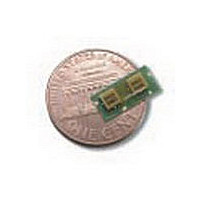HPMD7904TR1 Avago Technologies US Inc., HPMD7904TR1 Datasheet - Page 13

HPMD7904TR1
Manufacturer Part Number
HPMD7904TR1
Description
Manufacturer
Avago Technologies US Inc.
Datasheet
1.HPMD7904TR1.pdf
(16 pages)
Specifications of HPMD7904TR1
Pin Count
3
Screening Level
Commercial
Lead Free Status / Rohs Status
Not Compliant
13
Turn the board over and solder the connector fin-
gers to the board’s top ground plane, taking care to
flood the area with sufficient solder as to completely
cover the small crescent of exposed teflon. See Detail
B in Figure 27.
Figure 27. Connector details.
To obtain a demo board, contact your Avago Tech-
nologies sales representative.
Figure 28. Assembled demo board.
Duplexer S-parameter Files
Three port S-parameter files are available for the
Avago FBAR duplexer, both in narrow band form
(1820 to 2020 MHz in 0.5 MHz steps) and wideband
form (1 to 6 GHz). These files are in Touchstone
format, compatible with ADS and other simulation
software. They are useful in performing simulations
of the duplexer under various conditions, with
external matching networks, parasitics, etc.
However, care must be exercised when considering
an external impedance matching network for the
duplexer. Consider the simple L-C network simulated
in ADS and shown in Figure 29. This network was
added to the Tx port in an attempt to increase the
return loss over the 1850 to 1880 MHz portion of the
Tx band. Figure 30 shows the effect of this matching
network, with “before” given in red and “after” in blue.
The goal of return loss improvement is made. How-
ever, an examination of Figure 31 will show that a
small reduction in rejection over the upper half of
the Rx band resulted from the addition of this
impedance matching network. In Figure 32, it will be
seen that Tx to Rx port isolation was slightly improved
at the low end of the Rx band (1935 MHz) and reduced
over the high end of the Rx band, with no substantial
change over the Tx band.
Bear in mind that the addition of any external
impedance matching network, or parasitic reactance
(such as from poor quality connectors) will impact
the duplexer’s rejection and isolation performance.
Figure 29. Network simulated.
Figure 30. Tx port return loss.
Figure 31. Tx to Antenna insertion loss.
Figure 32. Tx to Rx isolation.















